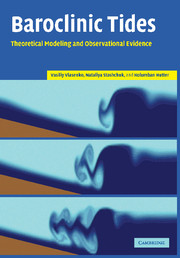Book contents
- Frontmatter
- Contents
- List of tables
- Preface
- Acknowledgements
- List of symbols
- List of abbreviations
- Preamble
- 1 General background
- 2 Linear baroclinic tides over variable bottom topography
- 3 Combined effect of horizontal density gradient and bottom topography on the dynamics of linear baroclinic tides
- 4 Topographic generation of nonlinear baroclinic tides
- 5 Evolutionary stages of baroclinic tides
- 6 Generation mechanism for different background conditions
- 7 Three-dimensional effects of baroclinic tides
- References
- Index
4 - Topographic generation of nonlinear baroclinic tides
Published online by Cambridge University Press: 14 August 2009
- Frontmatter
- Contents
- List of tables
- Preface
- Acknowledgements
- List of symbols
- List of abbreviations
- Preamble
- 1 General background
- 2 Linear baroclinic tides over variable bottom topography
- 3 Combined effect of horizontal density gradient and bottom topography on the dynamics of linear baroclinic tides
- 4 Topographic generation of nonlinear baroclinic tides
- 5 Evolutionary stages of baroclinic tides
- 6 Generation mechanism for different background conditions
- 7 Three-dimensional effects of baroclinic tides
- References
- Index
Summary
The basic relations of the linear theory presented in Chapters 2 and 3, and the results obtained with them, are valid within the framework of the linear approximation; i.e. the assumption that the amplitudes of the internal waves are infinitely small is assumed to be satisfied with sufficient accuracy. In such circumstances, the role of the nonlinear terms of the governing equations describing the dynamics of waves could be shown to be negligible, and the terms marked by boxes in system (1.39) could be omitted. This assumption is commonly used at low intensity of the external tidal forcing. However, such conditions are not valid for the whole area of the World Ocean. In many places they are not satisfied, because of either the strength of the forcing or the steepness of the topography, and numerous in situ data reveal a nonlinear wave response.
Obviously, a mathematical model which adequately describes nonlinear wave dynamics must be based on the complete system of nonlinear equations; it includes both the full advective nonlinearities and the nonhydrostatic law for the pressure. The model must also incorporate all those factors which control the structure of the wave fields: variable bottom topography, fluid stratification, external forcing, parameterization of background mixing, etc.
- Type
- Chapter
- Information
- Baroclinic TidesTheoretical Modeling and Observational Evidence, pp. 146 - 181Publisher: Cambridge University PressPrint publication year: 2005



